




Environmental Issues
The chapter Environmental Issues is from the unit Ecology and Environment and it plays an important role in NEET 2026 examination. Many important questions can be asked and thus the summary for last-minute revision is very crucial. This document fulfils the need. Environmental issues NCERT pdf uploaded on Vedantu's page can also be downloaded for offline access to the content.
‘Environmental Issues’ chapter carries the topics such as air pollution and its effects, water pollution, solid wastes, radioactive waste, global warming, deforestation and important topics that a student should know about. This synopsis of the chapter can be helpful to the students in gaining a good understanding of the chapter.
Important Topics of Environmental Issues
Air Pollution
Water Pollution
Solid wastes Pollution
Greenhouse Effect
Global warming
Ozone Depletion
Deforestation
Eutrophication
Biological Oxygen Demand
Important Concepts of the Chapter
Environmental Issues
An environmental issue is identified as any human activity that has a negative impact on the environment. As a result, the quality of the air, water, and soil deteriorate. These negative alterations frequently result in environmental problems that disrupt the natural balance of the environment.
Types of environmental issues may include Pollution, Global Warming, Solid Waste, Depletion of Natural Resources, and Deforestation.
Pollution
Pollution is the unwanted alteration in air, water, or soil caused by chemical, particulate matter, or biological contaminants. The agents which are responsible for causing pollution are called pollutants. To combat pollution, the Indian government passed the Environment (Protection) Act, 1986, which aims to safeguard and improve the quality of our environment (air, water, and soil).
The various of pollution can be:
Air pollution
Water pollution
Noise pollution
Soil pollution
Radioactive pollution
Air Pollution
All living species require air for respiration. Pollutants limit agricultural development and yield while also causing plants to die prematurely. Pollution's negative impact on all living species is determined by:
Pollution concentration.
The length of the exposure.
There are organisms involved.
Control of Air Pollution
Electrostatic Precipitator:
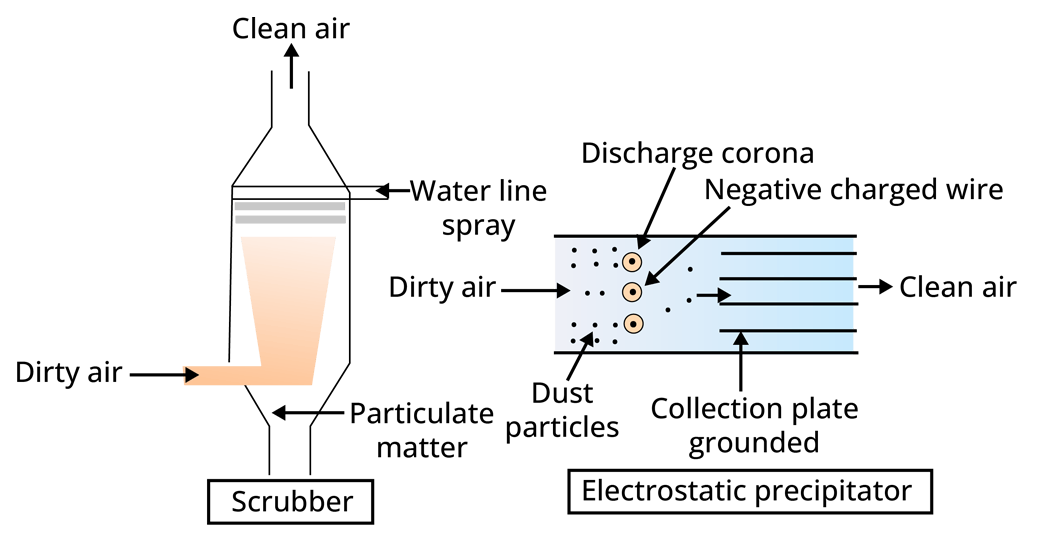
An Electrostatic Precipitator can eliminate over 99 per cent of the particulate particles in thermal power plant exhaust.
It has electrode wires that are kept at thousands of volts in order to create a corona that releases electrons. Dust particles gain a net negative charge as a result of these electrons attaching to them. The charged dust particles are attracted to the grounded collection plates, allowing clean air to pass through the electrostatic precipitator. Sulphur dioxide can be removed using a scrubber. The exhaust is filtered using a water or lime spray.
Other Methods
Automobile maintenance, as well as the usage of lead-free gasoline or diesel, can help to lessen the toxins they release.
Catalytic converters, which use expensive metals such as platinum, palladium, and rhodium as catalysts, are installed in automobiles to reduce toxic gas emissions.
Unburned hydrocarbons are transformed into carbon dioxide and water, while carbon monoxide and nitric oxide are turned into carbon dioxide and nitrogen gas, respectively, as the exhaust travels through the catalytic converter.
Since the lead in gasoline inactivates catalytic converters, unleaded gasoline should be used in vehicles equipped with them.
Converting all public transportation to run on compressed natural gas.
Water Pollution and Its Control
Humans and other creatures both rely on water bodies for survival. Ponds, lakes, streams, rivers, estuaries, and oceans are becoming contaminated in numerous parts of the world as a result of garbage disposal and other anthropogenic acts. To conserve water resources, the Indian government passed the Water (Prevention and Control of Pollution) Act, 1974.
Domestic Sewage and Industrial Effluents
Domestic sewage is made up of sewage from homes and businesses. Domestic sewage is unsafe for human consumption if it contains even 0.1 per cent contaminants. Solid wastes are fairly simple to remove, but soluble salts such as nitrates, phosphates, and other nutrients, as well as hazardous metal ions and organic compounds found in household wastes, are more problematic.
Domestic sewage primarily contains biodegradable organic waste that microbes such as bacteria and fungi may quickly break down. They get their nourishment from organic garbage.
Biological Oxygen Demand - BOD
Microbes that digest organic wastes in water bodies use a lot of oxygen, resulting in a dramatic drop in dissolved oxygen downstream from the sewage discharge point. Fish and other aquatic species die as a result of this.
The amount of oxygen required if all of the organic matter in one litre of water was oxidised by bacteria is referred to as BOD. The BOD test determines how quickly microorganisms in a sample of water absorb oxygen. BOD is an indirect measure of the amount of organic matter in the water. The higher the BOD of wastewater, the greater the risk for pollution.
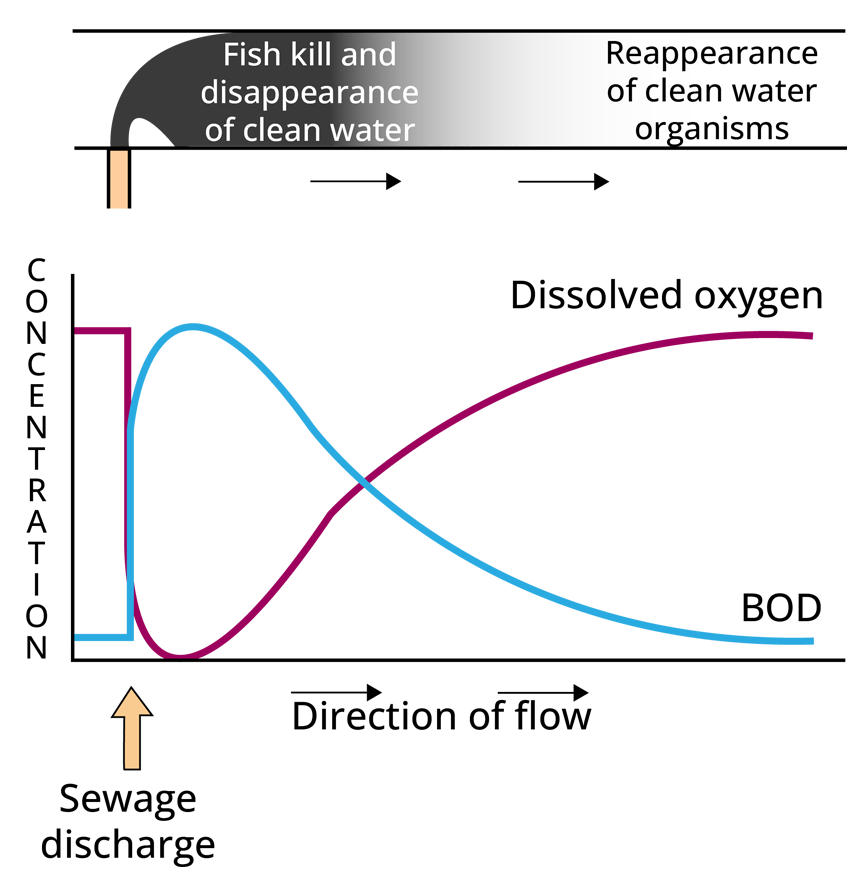
Algal Bloom
Excessive growth of planktonic (free-floating) algae, known as an algal bloom, occurs when huge levels of nutrients are present in water, giving the water a characteristic colour.
Algal blooms cause water quality to deteriorate and fish mortality to increase. Eichhornia crassipes, popularly known as the 'Terror of Bengal,' is the world's most troublesome aquatic weed. They thrive in eutrophic water bodies, causing an imbalance in the water body's ecosystem dynamics.
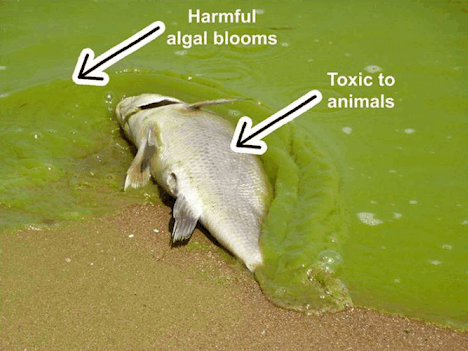
Biomagnification
The term "biomagnification" refers to an increase in the toxicant's concentration at successive trophic levels. It occurs when a harmful material accumulated by an organism is unable to be metabolised or expelled and is consequently passed on to the next higher trophic level.
This is a well-known phenomenon in the case of mercury and DDT. DDT in high quantities disrupts calcium metabolism in birds, causing eggshell thinning and premature breakage, eventually leading to a bird population decrease.
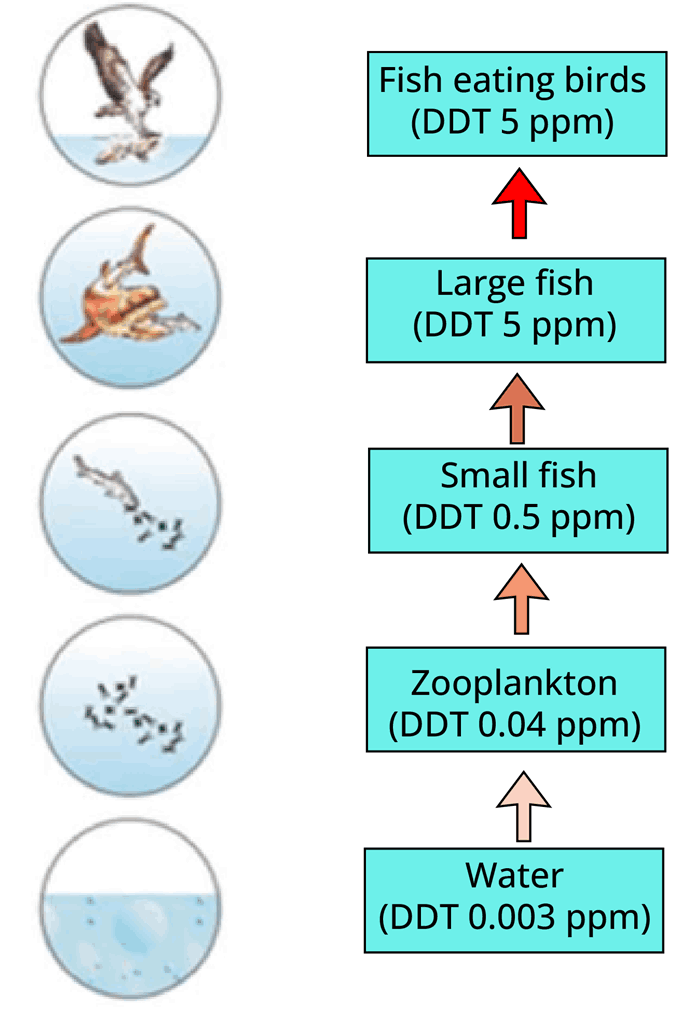
Eutrophication
Organic detritus accumulates at the bottom of a lake over time, causing it to age. Large masses of floating plants eventually form, eventually turning to land. Over time, this encourages the growth of marsh plants, filling in the original lake basin.
Pollutants from man's activities, such as effluents from enterprises and dwellings, hasten the ageing of the lake dramatically. Cultural or Accelerated Eutrophication is the name given to this phenomenon.
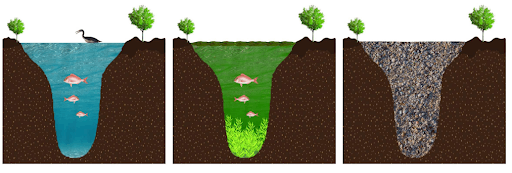
Solid Wastes
Everything and anything that flows out in the trash is referred to as solid waste.
Municipal solid wastes are wastes collected and disposed of by the municipality from homes, offices, stores, schools, and hospitals, among other places.
Open-burning dumps were phased out in favour of sanitary landfills.
All of the waste we produce may be divided into three categories: biodegradable, recyclable, and nonbiodegradable.
Electronic trash includes irreparable computers and other electronic goods (e-wastes).
E-waste is either buried in landfills or burned.
Global Warming
The progressive increase in the average temperature of the Earth's atmosphere is referred to as global warming. This occurs as a result of rising quantities of greenhouse gases in the atmosphere, which prevents heat from escaping into space, causing the world to warm. It is a major environmental problem that is brought about by both natural and human factors.
The following are the primary causes of global warming:
Industrialisation
Deforestation
Factory farming
Emissions from vehicles
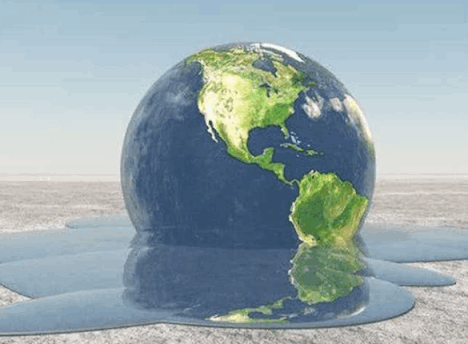
Ozone Depletion
Ozone, which is present in the stratosphere at the top of the atmosphere, works as a shield, absorbing UV energy from the sun. UV rays are extremely harmful to living things.
In terms of Dobson units, the thickness of the ozone layer in a column of air from the ground to the top of the atmosphere is measured (DU). UV rays are absorbed by the ozone layer. It causes skin ageing, cell damage, and several types of skin malignancies. The cornea of the human eye absorbs UV-B radiation, and a high dose of UV-B produces corneal inflammation, which is known as snow-blindness cataract, and other conditions. The cornea may be irreversibly damaged as a result of this exposure.
The ozone layer is depleted by chlorofluorocarbons. The ozone hole is the area in the atmosphere with the lowest concentration of ozone.
Steps that lead to ozone depletion include:
UV rays decompose CFCs and release atomic chlorine (Cl).
Ozone is also changed into oxygen by UV radiation.
Chlorine atoms trap oxygen atoms, preventing the formation of ozone from oxygen. This causes ozone depletion in the stratosphere.
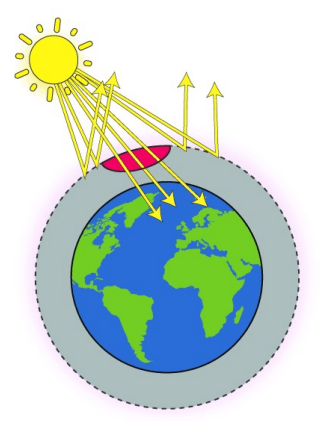
Deforestation
Human actions such as slash and burn have resulted in the change of wooded areas to non-forested areas. Farmers cut down trees and burn the plant remains in agriculture, commonly known as Jhum farming. The area is then used for agricultural or cattle grazing, as well as the usage of fertilisers and tree chopping for industry and residential purposes. The following are some of the most significant consequences of deforestation:
Carbon dioxide concentrations have increased
Biodiversity decline
Hydrologic cycles that have been disrupted
Erosion of the soil
Desertification, for example.
Reforestation is the process of replanting a forest that has been cut down at some point in the past.
Movements for stopping deforestation:
Chipko Movement: In 1974, native women in the Garhwal Himalayas showed incredible bravery by clutching trees to protect them from axe-wielding men.
Joint Forest Management: The Indian government created the concept of JFM in the 1980s to work closely with local people to protect and manage forests.
Solved Examples from the Chapter
1. Read the following statements and find out the incorrect statement.
Solids are relatively easy to remove from domestic sewage.
Dissolved salts such as nitrates and phosphates, toxic metal ions and organic compounds are most difficult to remove.
Presence of large amounts of nutrients in waters causes excessive growth of fishes and other aquatic creatures.
None of the above
Ans: c. Presence of large amounts of nutrients in waters causes excessive growth of fishes and other aquatic creatures.
Algal blooms are caused by the presence of significant concentrations of nutrients in the water. Algal blooms deprive other aquatic species, particularly fish, of oxygen, resulting in their death.
Key point to remember: Algal bloom is characterised as the rapid growth of microscopic unicellular algae, not macroscopic algae.
2. The concept of Joint Forest Management (JFM) involves
Conservation of forest and agricultural land by the government
Conservation of forests and wildlife by the local communities
Work in close association with the local communities for protecting and managing forests
Exploitation of beneficial forest products only.
Ans: c. Work in close association with the local communities for protecting and managing forests
Joint Forest Management (JFM) is an idea that entails working closely with local communities to maintain and manage forests. In the 1980s, the government enacted a strategy for joint forest management.
Key point to remember: People in the villages receive various forest products in exchange for their services to the forest, including fruits, gum, rubber, medicine, and so on, and the forest is thus sustainably protected.
3. DDT residues are rapidly passed through the food chain causing biomagnification because DDT is
water soluble
lipid soluble
moderately toxic
non-toxic to aquatic animals
Ans: b. lipid soluble
DDT is a pesticide that contains chlorine and is used in agriculture. Because DDT is stable, it gathers in the soil and concentrates in the fatty tissue or internal organs of the body, further it moves quickly through the food chain, leading to biomagnification.
Key point to remember: Biomagnification happens due to the gathering of DDT in the internal organs of the body.
Solved Problems of Previous Year Question from the Chapter
1. Montreal protocol was signed in 1987 for control of:
Release of GreenHouse gases
Disposal of e-wastes
Transport of Genetically modified organisms from one country to another
Emission of ozone depleting substances
Ans: d. Emission of ozone depleting substances
The Montreal Protocol is an international agreement that aims to protect the ozone layer by phasing out the manufacture of a variety of compounds that cause ozone depletion.
2. Snow - blindness in Antarctic region is due to :
High reflection of light from snow
Damage of retina caused by infra-red rays
Freezing of fluids in the eye by low temperature
Inflammation of cornea due to high dose of UV - B radiation
Ans: d. Inflammation of cornea due to high dose of UV - B radiation
The cornea of the human eye absorbs UV-B radiation, and a high dose of UV-B induces corneal inflammation, which is known as snow-blindness. Overexposure to ultraviolet (UV) light causes this painful eye ailment.
The effects of UV light on the cornea cause cornea sunburn.
3. In the stratosphere, which of the following elements acts as a catalyst in the degradation of ozone and release of molecular oxygen?
Fe
Cl
Carbon
Oxygen
Ans: b. Cl
Chlorine combines with ozone in the ozone layer, causing ozone breakdown and the release of an oxygen molecule as well as molecular oxygen. After each reaction, it mixes with free oxygen and begins the reaction with another ozone molecule, acting as a catalyst for ozone degradation.
Practice Questions
1. Ozone depletion is occurring widely in
Troposphere
Stratosphere
Ionosphere
All of these
2. In the human eye, the cornea absorbs UV-B radiation and a high dose of UV-B causes
Inflammation of the cornea
Cataract
Permanently damage to the cornea
All of the above
3. A global agreement to reduce the release of ODS is
Vienna Convention
Rio de Janeiro conference
Kyoto protocol
Montreal protocol
1. Ans: b. Stratosphere
Ozone depletion is widespread in the stratosphere, with a concentration over the Antarctic region.
2. Ans: d. All of the above
The cornea of the human eye absorbs UV-B radiation, and a high dose of UV-B can induce corneal inflammation, cataracts, and even irreversible damage to the cornea, resulting in blindness.
3. Ans: b. Rio de Janeiro conference
Rio de Janeiro Conference was held in the year 1992 to address serious worldwide issues of environmental conservation and socio-economic development.
Conclusion
The summary of the chapter Environmental Issues can help a student go through the chapter in a single go and make the learning easy. Further, the environmental issues neet questions, sample questions and practice questions have been searched and added to the document so that the student can have clarity over the topics that have been repetitively asked. Also, practising these questions can bring an understanding of the formatting for NEET 2026 examination.
NEET Important Chapter - Environmental Issues

 Share
ShareFAQs on NEET Important Chapter - Environmental Issues
1. What is the percentage weightage of the unit Ecology and Environment?
The unit Ecology and Environment comprises the four chapters namely, Organisms and Populations, Ecosystem, Biodiversity and its Conservation and Environmental Issues. The total weightage of the chapter is 6% for the NEET Examination.
2. Is chapter Environmental Issues important for NEET Examination?
Just like any other chapter, this chapter is equally important as every single question can help you in gaining a good score in the examination. There are many important topics in the chapter which are to be taken care of and to be practised thoroughly. So, there is no such chapter that can be ignored or avoided for the NEET examination.
3. What is the secret to passing the NEET Exams?
There is no magic technique to pass the NEET 2022 exams. If you want to do well in the exams, you must work hard and prepare extensively. However, you should plan your study based on the importance of the chapters and the various notes or materials that you use. For successful revision of your learning, you should also make it a point to go over crucial questions and solve prior question papers.




















 Watch Video
Watch Video


